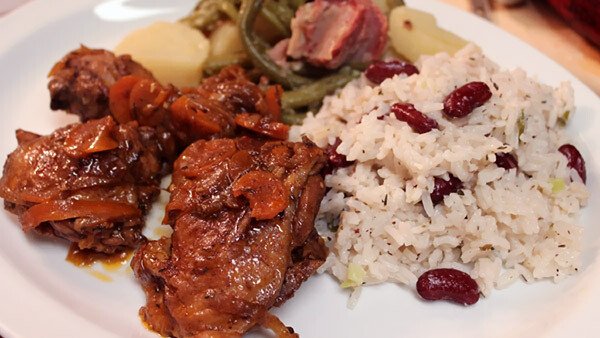
Stewed Chicken Recipe – Nevis Style
Toledo, Ohio
March 09, 2008
As I sit here in the Midwest, freezing my backside off in 10 inches of snow, I thought about this recipe. I thought what I need is something, comforting, tropical, and spicy to chase away the winter blues. This recipe is an adaptation of a recipe June France in Newcastle, Nevis taught me. You can use Habanero peppers in place of Scotch Bonnet peppers if need be, just add 1 more of the Habanero peppers.
Stewed Chicken Recipe Ingredients:
1 whole 6 lb chicken, halved or cut into pieces
12 garlic cloves
4 Scotch Bonnet peppers
8 medium Spanish onions, quartered
1.5 cup dark rum
1.0 cup soy sauce
1.0 cup vegetable oil
1.0 cup fresh thyme
1.0 cup lime juice
1.0 cups fresh parsley
0.5 cups fresh ginger grated
0.5 cups brown mustard
Stewed Chicken Recipe Cooking Method:
In a food processor, combine garlic, peppers, onion, rum, soy sauce, vegetable oil, thyme, lime juice, parsley, ginger and mustard. Pulse to form a thick marinade sauce . Place the chicken pieces in a large Ziploc style plastic bag and pour the sauce over the chicken. Seal and give it a shake to coat. Refrigerate for up to four hours, 2 hours minimum. Preheat the oven to 350. Remove the chicken from the bag, reserving the marinade.
Arrange chicken on a baking dishes so they don’t overlap. Bake 1 hour or until cooked through. In a small saucepan, heat the remaining sauce. Take care to bring to a low simmer for at least 20 minutes the sauce as it has been in contact with raw chicken (add water if sauce becomes to thick). Serve the stewed chicken recipe with sauce on the side.
Really good with rice and peas too…OK I am off to the market for groceries…if my driveway is plowed
What Is A Stewing Chicken
A stewing chicken is a retired egg layer. Stewing hens are an important component for honoring the life cycle of a farm. After several happy years eating grass and bugs, a hen’s egg laying ability naturally slows down, and she’s no longer a productive member of the flock. In order to keep up with the demand for eggs, farms must cull these older hens in order to make space for new layers. Butchering and selling these hens provides a revenue source for farms and allows the hen to continue to provide nourishment, this time in the form of high quality, pastured meat.